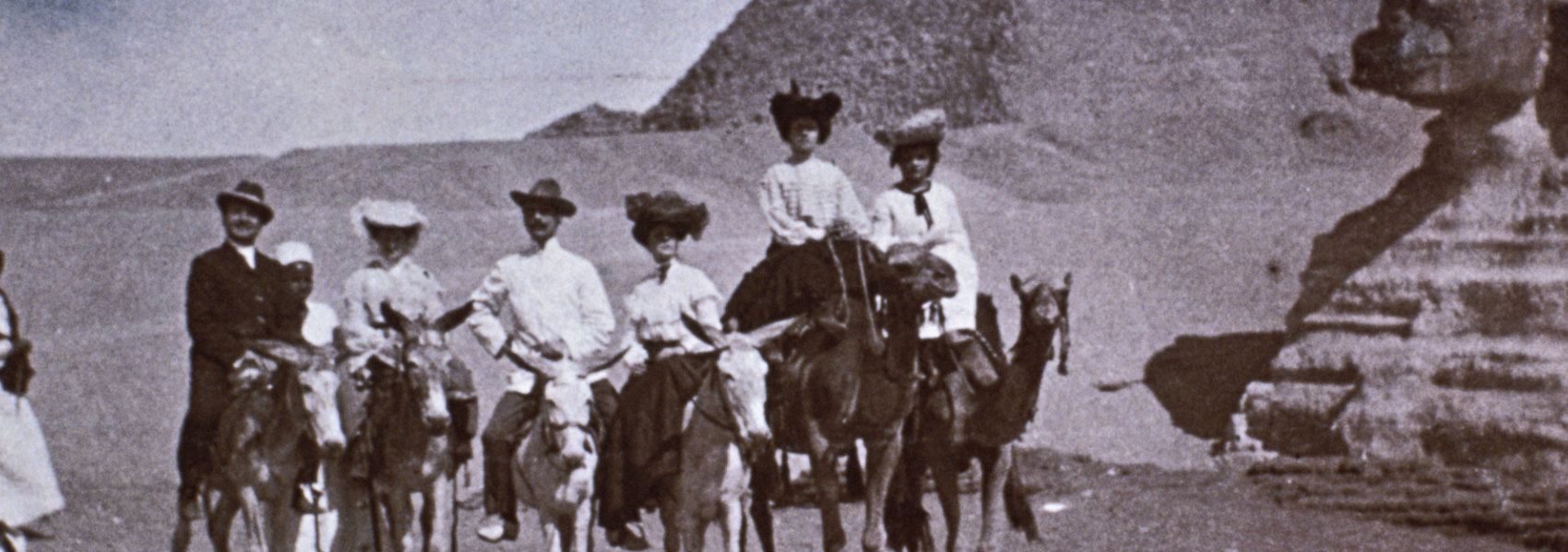
Published 29th Oct. 2025
Written by Tom Holland
Reading time
This article originally featured in the first edition of our magazine, Original Traveller. The world’s first tourist destination; Egypt has attracted the great and the good for more than four millennia. Tom Holland charts the ebb and flow of the country’s time travel.
Egypt is where tourism began. Perhaps this is hardly surprising. By the 5th century BC, when the first tourist guide to Egypt was written, pharaonic civilisation was already more than two and a half millennia old. In that time, many stupefying monuments had been built: pyramids, temples, obelisks. Nowhere in the world boasted such an astonishing concentration of wonders. ‘Reason enough, then,’ in the words of one particular visitor, ‘to describe it at some length.’
The visitor was a Greek. His name was Herodotus – ‘the Father of History’, according to Cicero – and the account he wrote of Egypt stands as the fountainhead of all the many guides to the country written since. He was not, of course, the first foreigner drawn to the land of the Nile. Egypt was fabulously wealthy. There were many beyond its borders who craved its gold. The oldest representation of an Egyptian king ever identified – found in a grave dating back to around 3800 – shows a tall figure wielding a mace with which he menaces three tethered captives. Century after century, millennium after millennium, it remained the abiding duty of Pharaoh to keep the borders of his kingdom proof against such barbarians. Equally – as the Bible bears witness – outsiders continued to flock to the country. ‘Behold, I have heard that there is corn in Egypt: get you down thither and buy for us from thence; that we may live, and not die.’ In times of famine, where else were supplicants like the children of Israel to go?

Image by NNehring / iStock / Getty Images
Herodotus, however, was different. When he travelled to Egypt, it was not to get rich, nor in search of corn. He came to gawp at everything that made the country distinctive, and to tour its wonders. His itinerary was one that tourists today would have no problem in recognising. He visited the Pyramids of Giza. He poked around temples and labyrinthine funerary complexes. He marvelled at the Nile. Herodotus, however, was not only interested in ancient monuments and natural wonders. He was fascinated as well by the Egyptians themselves. ‘In almost all their customs and practices,’ he reported, ‘they do the exact opposite of the rest of mankind.’ The women urinated standing up, and the men squatting down. The crocodiles wore ear-rings. The dead were mummified. Herodotus – eager to talk to everyone, fascinated by everything, just gullible enough never to be boring – remains to this day a wonderful tour guide.
The Greeks never lost their fascination with Egypt. Awe at the sheer scale and antiquity of the country’s monuments was mingled, in the case of many who journeyed to the country, with a certain contempt. The legacy of this ambivalence has been an enduring one. A ‘pyramid’ in Greek was a small bun with triangular sides. An ‘obelisk’ was a cooking spit. A ‘crocodile’ was a garden lizard. Some Greeks would go into raptures over Egypt as the home of hidden wisdom; others, finding themselves next to the colossal statue of some pharaoh, would scratch their names onto his leg. ‘Like an Egyptian temple: amazing to look at, but inside you will find a priest singing a hymn to a cat.’ So the Greek saying went.
No wonder, then, in 331 BC, when Alexander the Great conquered Egypt and founded a new capital, that he should have planted his city on the coast. Suspended between the sea and the desert, Alexandria was a city where statues of Apollo and Athena stood in the streets alongside those of deities with the heads of animals. It was a city of superlatives: celebrated across the Mediterranean for its library and its lighthouse, its spectacular palaces and its slot-machines. Even Romans – who generally despised anywhere that was not Rome – yearned to visit it. ‘Yes,’ confessed the great orator Cicero, ‘I dream, and have long dreamed, of seeing Alexandria.’

Image by Duncan1890 / iStock / Getty Images
Unsurprisingly, then, when Egypt – following the final defeat and suicide of Cleopatra in 30 BC – was absorbed into the Roman Empire, a mania for all things Egyptian swept Rome. Tourism, however, was severely restricted. Egypt, rich and fertile, was the private fiefdom of the Caesars. Senators were banned from setting foot in it. The risk that one of them might use it as a base for an insurrection was viewed as too great. Tourism to the country became, as a result, fabulously exclusive – reserved for emperors and their intimates. It was Julius Caesar, who had arrived in Alexandria back when Cleopatra was still a young woman and conducted a passionate affair with her, who had set the trend. The two of them, Roman general and Egyptian queen, had sailed down the Nile together on a luxury cruise. Indeed, so it was reported by one biographer, ‘had his army not refused to follow him, he would have sailed the whole way with her to Ethiopia.’
A number of emperors, following in Caesar’s wake, made a similar voyage down the Nile. Their prime goal was Luxor, and the colossal statue of a seated man. This, in the opinion of the age, was the single greatest tourist attraction in the whole of Egypt. Although in reality the statue portrayed Amenhotep III, the grandfather of Tutankhamen, it was believed by Roman visitors to show an ancient hero named Memnon, an Ethiopian who had fought in the Trojan War, and been the son of the Dawn. Evidence for this identification was to be found in a miraculous phenomenon: at certain times during the early spring, at first light of day, the base of the statue would sing. Or rather, it would hum: for the sound, according to one travel writer, resembled the vibration of a single lyre string. ‘Memnon’s voice rang out like struck bronze, high-pitched.’ So wrote a poet, Julia Balbilla, who in AD 130 had accompanied the emperor Hadrian to Luxor, and heard Memnon sing. Masons, acting on commission, chiselled four of her poems onto the side of the statue. Carved with great skill and precision, this was graffiti intended to last.
By the end of the 2nd century, however, Memnon’s song had faded and vanished forever. Much more was to fade and vanish as well. Egypt in the time of Hadrian bore witness to continuities – of worship, of culture, of language – that reached back over 3,000 years. The coming first of Christianity and then of Islam drew a line under that fabulously lengthy chapter. The temples were given over to sand; the customs that had so intrigued Herodotus abandoned; the meaning of the hieroglyphs forgotten. The tourists who in Hadrian’s day had visited pharaonic monuments were replaced by a new category of sightseer: pilgrims. Alexandria, once the intellectual powerhouse of paganism, was reconsecrated as something new: as ‘the most glorious and Christ-loving city of the Alexandrians.’ Monks took to the desert, where their prodigies of asceticism proved an irresistible draw to the devout. A monastery was planted at the foot of Mount Sinai. Then, with the conquest of Egypt by the Arabs in 642, the country became even more of a palimpsest. New destinations, new landmarks, new objects of pilgrimage came to be founded. By the year 1000, Egypt had become a veritable powerhouse of Islamic civilisation: home to stunning mosques, exquisite calligraphy, and an entire new capital, dazzling and puissant, by the name of Cairo. To this day, the great university founded there in 972, Al-Azhar, remains the most celebrated and influential in the entire Islamic world.

Image by Fototeca Gilardi / Photodisc / Getty Images
Meanwhile, looming on the margins of the imaginings of Christians and Muslims alike, the wreckage of ancient Egypt endured. Pharaoh, in both the Bible and the Qur’an, served as the very archetype of idolatry; and so the monuments to his glory tended to be regarded by the faithful at best with disinterest, at worst with fear. Nevertheless, visitors to Cairo could not help but be aware of the pyramids; and many were the pilgrims who walked from the city to wonder at them. Christians had long identified them as the granaries built by Joseph (he of the technicolour dream coat); but by the 16th century, as the fascination of Renaissance scholars with antiquity came to exert an ever-stronger influence, Italians began to visit Egypt, not as pilgrims, but as tourists. In 1589, for instance, a Venetian travelled all the way to Luxor; ‘and my sole reason,’ as he put it, ‘was to see so many superb buildings, churches, colossal statues, needles and columns.’
He was to prove a trailblazer. In the centuries that followed, growing numbers of Europeans followed in his wake. The most celebrated expedition, and easily the most influential, was that of Napoleon in 1798. ‘Soldiers,’ he declared ringingly before the battle of the Pyramids, the great victory which won the French temporary control of Egypt, ‘remember that forty centuries of history gaze down upon you from these monuments!’ Napoleon had come as a conqueror; but he had also come as a tourist. In his knapsack he had a copy of Herodotus, and in his train an entire army of savants. Given free range across Egypt, these various scholars compiled the first great modern survey of the country’s antiquities. The impact across Europe was seismic. The study of ancient Egypt was revolutionised. In 1828, when a French linguist named Jean-François Champollion landed in Alexandria, he did so as the man who, over the course of the previous decade, had deciphered hieroglyphs. Travelling up the Nile to Luxor, he was the first sightseer since Roman times to be able to read the ancient monuments.
It was not only scholars, however, who were gripped by Egyptomania. In 1869, at the grand opening of the Suez Canal, one of the guests was an Englishman named Thomas Cook: an entrepreneur who had pioneered travel for the growing middle classes. He was in Egypt at the head of his very first tour of the Orient; and in the years that followed he laboured hard to establish a tourist industry in the country. Backed by an impecunious Egyptian government dependent on Britain for its survival, he built an entire infrastructure pretty much from scratch: leasing steamships to churn up and down the Nile, employing armies of translators and guides, importing tinned food all the way from Blighty. By 1884, when the British colonial government was looking to transport an expeditionary force from Alexandria to Sudan, in the vain hope of rescuing General Gordon in Khartoum, there was only the one way to do it: commission Thomas Cook.

Image by iStockphoto / Getty Images
By the turn of the century, the tourist industry was such that Egypt had become firmly established as the favourite winter destination of well-heeled Western tourists. Travellers could leave the icy cold of Northern climes, and find, aboard a steamship or in a luxury hotel, all the familiar comforts of home. They could also take up new hobbies. When Lord Carnarvon, advised by his doctors to winter in Egypt after a serious motoring accident, arrived on the banks of the Nile, it did not take him long to become obsessed by archaeology. The ultimate fruit of his new passion – the discovery, in 1922, of the still intact tomb of Tutankhamen – turbocharged yet another bout of Egyptomania. It has never faded since.
Today, a hundred years on from the discovery of Tutankhamen’s tomb, the fascination that Egypt exerts, not to mention the draw of its winter sun, has diminished not a jot. It remains one of the supreme global tourist destinations. Terrible though the past two years have been for everyone, the Egyptian government has not been wasting the lockdown. A spectacular new museum – The Grand Egyptian Museum – complete with the funerary treasures of Tutankhamen, the royal mummies, and the largest array of archaeological objects held by any museum in the world, is due to open at Giza later this year [the original article was written in 2022]. Today, as it has always done, Egypt bears witness to the abiding truth of Herodotus’ judgement on the country: ‘it is a land which boasts an inordinate number of wonders, and possesses more monuments surpassing description than any other.’
Header image by Fototeca Gilardi / Stockbyte / Getty Images
Written by Tom Holland - Historian and Co-host of The Rest is History Podcast
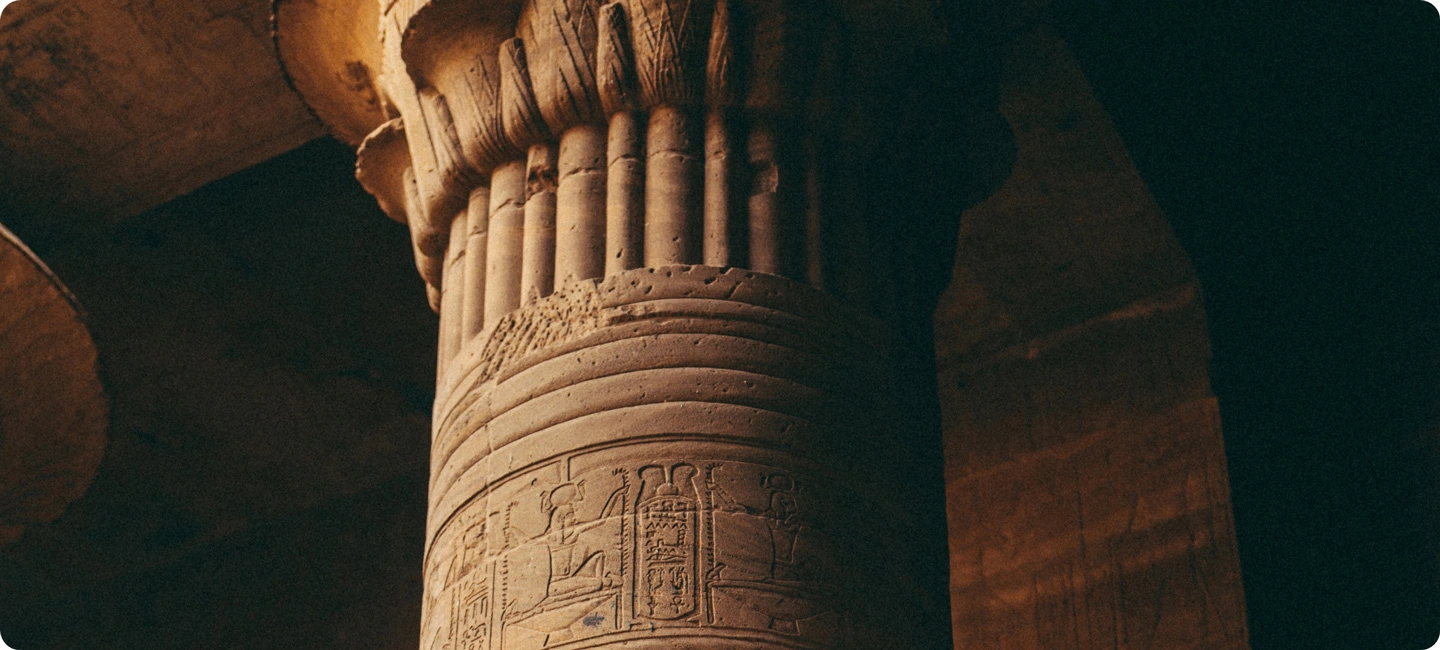
When it comes to Egypt’s Nile, we’ve secured full bragging rights with exclusive access to the Steam Ship Sudan, the last of the authentic paddle steamers which also served as inspiration for Agatha Christie. If it’s the lesser-known sites you’re after, we can instead bag you a cabin onboard the Flâneuse du Nil, a traditional dahabieh sailing boat that plies the Nile. We’ve also got the best guides under our belt for exclusive access to the Pyramids, temples and tombs of Egypt, and our handy app is home to an ever-growing list of tried and tested shops, restaurants and more.
ENQUIRE NOWPractical advice and inspiration for your next trip
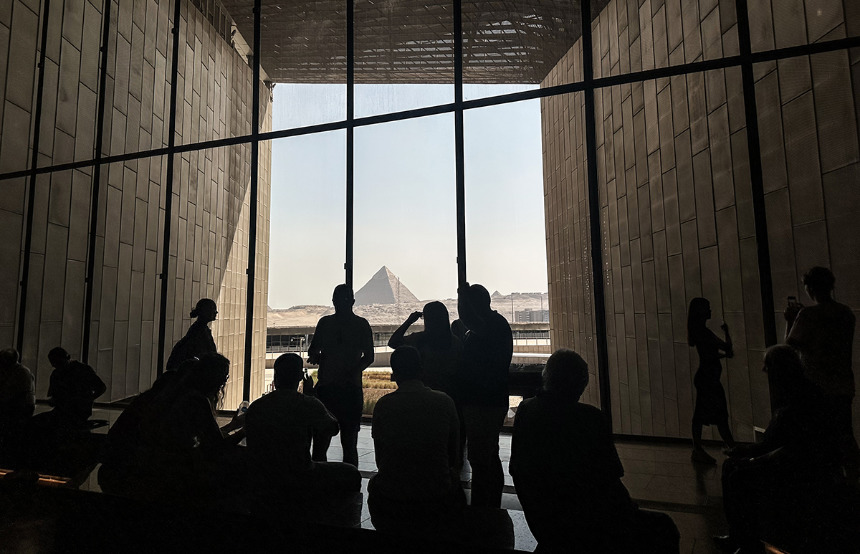
As Tom Holland (the esteemed historian, not Spiderman) so succinctly put it in the first edition of our magazine, Original Traveller, ‘Egypt is where tourism began’. And the next chapter in the history of tourism in Egypt is about to begin. We’re always looking for a reason to shout about this captivating country, and this November, we have the perfect excuse: the long-awaited opening of the Grand Egyptian Museum (GEM).
3rd November 2025 - Egypt Culture
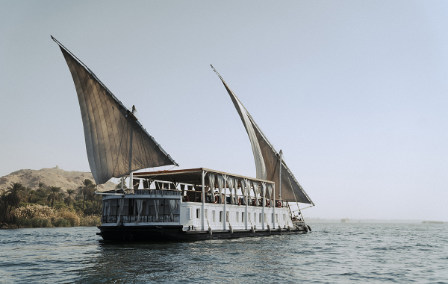
On a research trip to Egypt, our Content Manager, Ella, soaked up the storied sights lining the banks of the Nile onboard the Flaneuse du Nil. Elegant and intimate, this traditional dahabieh sailing boat journeyed from Aswan to Esna, leading her to archaeological hotspots and ancient temples. She explored the sandstone quarries of Gebel el-Silsila, admired ancient carvings in Kom Ombo and dined like a Pharaoh on the sailing boat’s sundeck.
7th May 2025 - Egypt Travel Tips
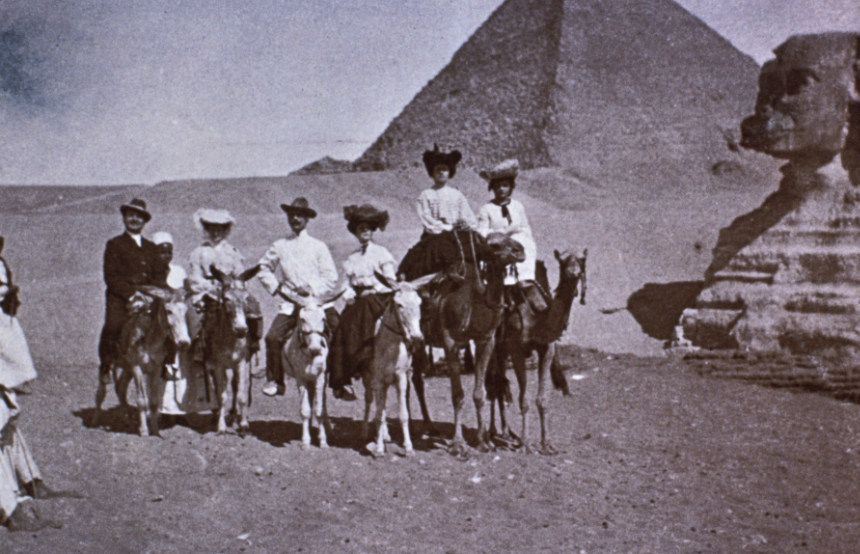
This article originally featured in the first edition of our magazine, Original Traveller. The world’s first tourist destination; Egypt has attracted the great and the good for more than four millennia. Tom Holland charts the ebb and flow of the country’s time travel. Egypt is where tourism began. Perhaps this is hardly surprising. By the 5th century BC, when the first tourist guide to Egypt was written, pharaonic civilisation was already more than two and a half millennia old.
29th October 2025 - Egypt Travel Inspiration

Our team of destination experts will get to know you and your unique requirements for your holiday

We work with you to build an ultra-personalised holiday itinerary with your choice of accommodation, experiences and activities

All of our holidays include little extras designed to make a big difference to your trip, from fast-tracking you through airport check-in and security to our network of local Concierges